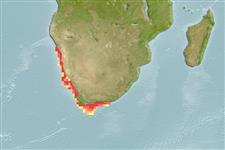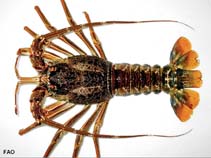Jasus lalandii (Milne-Edwards, 1837)
Cape rock lobster| Native range | All suitable habitat | Point map | Year 2050 |

|
| This map was computer-generated and has not yet been reviewed. |
| Jasus lalandii AquaMaps Data sources: GBIF OBIS |
Classification / Names Common names | Synonyms | CoL | ITIS | WoRMS
| Decapoda | Palinuridae
Environment: milieu / climate zone / depth range / distribution range पारिस्थितिकी
; गहराई सीमा 0 - 200 m (Ref. 4). Subtropical, preferred 18°C (Ref. 107945); 21°S - 37°S, 12°E - 26°E (Ref. 4)
वितरण देश | ऐफ ऐ ओ क्षेत्र | Ecosystems | संयोग | भूमिका
Southeast Atlantic: Namibia to South Africa.
Length at first maturity / आकार / वज़न / Age
Maturity: Lm 6.6, range 5 - ? cm Max length : 46.0 cm BL पुल्लिंग / अलिंग; (Ref. 4)
It has a maximum total body length of 46 cm and a carapace length of 18 cm. Maximum depth from Ref. 113432. Fisheries: The tails of this species are exported frozen in the shell, or peeled and canned. Experimental work on culture techniques for this species are underway in South Africa. Protective measures includes a size limit (carapace length 8.5 cm), a closed season from July 1 to October 31, bag limits for sports fishermen (2 specimens per day), and the prohibition of taking ovigerous females or soft shelled specimens (Ref. 4). Occurs at depths from 0 to 46 m of coastal waters and inhabits rocky bottoms, sometimes with patches of sand and mud (Ref. 4).
Life cycle and mating behavior परिपक्व अवधि | पुनरुत्पत्ति | मछलीऔ का अंडे देना | अंडे | Fecundity | लार्वा
The males molt between September and December. In the females, molting occurs in April or May, after which copulation takes place. Ovigerous females are found from May to October (Ref. 4).
Main reference
संदर्भ | संयोजक | सहयोगीयो
Holthuis, L.B. 1991. (Ref. 4)
IUCN Red List Status (Ref. 130435)
Least Concern (LC) ; Date assessed: 03 December 2009
CITES status (Ref. 108899)
Not Evaluated
CMS (Ref. 116361)
Not Evaluated
Threat to humans
Human uses
मात्स्यिकी: व्यापारिक
FAO - मात्स्यिकी: landings | FishSource | Sea Around Us
साधन
अधिक जानकारी
इंटरनेट स्रोत
BHL | BOLD Systems | CISTI | DiscoverLife | FAO(मात्स्यिकी: ; publication : search) | Fishipedia | GenBank (genome, nucleotide) | GloBI | Gomexsi | Google Books | Google Scholar | Google | PubMed | Tree of Life | Wikipedia (Go, खोज) | Zoological Record
Estimates based on models
Preferred temperature
(Ref. 115969): 14.6 - 19.5, mean 16.7 (based on 12 cells).
लौटाव
(Ref. 69278):
निम्न, न्यूनतम जनसंख्या दुगनी होने का समय 4.5 - 14 वर्ष। (K=0.1-0.11).
Nutrients: Calcium = 109 [35, 184] mg/100g; Iron = 1.59 [1.21, 1.97] mg/100g; Protein = 20.2 [19.2, 21.3] %; Omega3 = 0.285 [0.185, 0.386] g/100g; Selenium = 48.3 [-31.7, 128.3] μg/100g; VitaminA = 0 μg/100g; Zinc = 1.79 [1.17, 2.40] mg/100g (wet weight).



